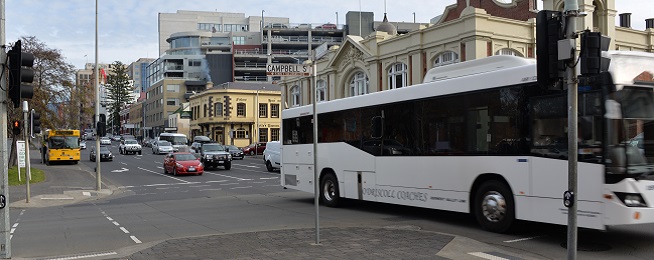Is Hobart sufferring traffic congestion? That’s what the Tasmanian Parliament’s Legislative Council will attempt to determine in a new inquiry that’s calling for submissions before 27 September.
The inquiry’s terms of reference are:
(1) the scope of Greater Hobart’s traffic congestion and its impact on the community and economy
(2) causes of congestion, including physical and topographical barriers
(3) strategic planning processes between Commonwealth, State and Local governments
(4) future initiatives to address traffic congestion in the Greater Hobart area
(5) any other matters incidental thereto.
While people in Sydney, Brisbane and Melbourne may scoff at the idea of Hobart traffic jams, the data shows a steady increase in the number of vehicles on the road over the past 30 years.
Traffic congestion doesn’t generally bother transport bike riders, but it is worthwhile engaging with the inquiry as one of the obvious ways to get people out of cars is to build comfortable, low-stress cycleways.
Bigger Australian cities have and are going down the path of building quality cycling corridors to combat traffic congestion.
Infrastructure Australia has included a plan to build 284km of cycleways in Sydney in its priority list because of its potential to reduce traffic congestion by between 20,000 and 50,000 motor vehicle trips a day within 10 km of the city centre.
And in European countries that have good cycling infrastructure, such as The Netherlands, Denmark and Germany, cargo bikes and electric bikes are getting more people out of cars again.
The university’s current and future city campuses and accommodation are a useful catalyst to getting cycleways built in Hobart as the staff and students won’t have the parking options that exist at the Sandy Bay campus.
What’s already happening
Several reports and background papers have come out in the past ten years about Hobart’s transport situation and what could change to improve rates of walking, riding and public transport.
The Legislative Councillor who moved for the inquiry, Robert Armstrong, expressed frustration in the parliament about plans and ideas not resulting in action.
As the Canadian urban planner Brent Toderian has so aptly put it: "The truth about a city's aspirations isn't found in its vision. It's found in its budget".
- The City of Hobart has released four background papers and a draft transport strategy is still waiting final approval by the council.
- The Gehl Report and the council’s response, the Inner City Action Plan, both deal with active transport links through Hobart. The cities of Hobart and Glenorchy also released a study into the development potential of the northern railway corridor in 2016.
- The City of Hobart and Tasmanian Government are working on a central precinct plan that is due for completion at the end of 2020.
- The Tasmanian Government released the Hobart Transport Vision just before the 2018 election.
- The Tasmanian Department of State Growth has embarked on planning studies for several transport corridors into the city, including the Tasman Highway, Channel Highway, Southern Outlet, and Domain and Brooker highways.
- The Tasmanian Government released the Southern Tasmania Regional Land Use Strategy in 2010, which runs until 2035.
- The Hobart City Deal is an agreement between federal, state and local government to work together to improve issues such as transport and included a pot of money for transport.
- The RACT went through an extensive public and expert consultation process this year to deliver its Greater Hobart Mobility Vision for the coming 30 years.
- The Tasmanian Bicycle Council released a plan this year for separated cycleways in the Hobart city centre to make it easier to complete the journey from one of the three main cycling corridors into the city.
What could governments do to to get more people riding?
- Create a standing cycling infrastructure fund for state and local roads.
- Plan and build a network of all abilities cycling corridors into and through the city.
- Fund research that maps parking availability, through-traffic levels and shopper transport choices to build the case for separated cycleways.
- Sequence traffic signals on designated routes to give priority to people walking and riding and public transport.
- Change planning laws so end-of-trip facilities and secure bike parking are included in all new buildings.
- Provide secure public bike parking and end-of-trip facilities in the city centre and satellite shopping hubs.
- Fix the Tasman Bridge to make it more comfortable for people riding.
- Provide incentives and support to workplaces to get more staff riding – e.g. bike fleets, e-bike leasing, e-bike subsidies, salary sacrificing.
- Integrate bike riding with public transport with secure bike-and-ride parking at bus hubs and retrofitting buses with exterior and/or interior racks for bicycles and ensure future public ferries are designed for easy ingress and egress of bicycles.
- Fund behaviour change programs like Ride2School and Ride2Work, and adult riding classes.
- Provide signage, wayfinding and maps to make it easier to ride.
Make a submission
The Legislative Council inquiry is accepting submissions until Friday 27 September.
Your submission can be as long or short as you want and address all or just one of the terms of reference.
Email your submission to ght@parliament.tas.gov.au, or post it to : The Secretary, Legislative Council Select Committee Greater Hobart Traffic Congestion, Legislative Council, Parliament House, HOBART 7000
To keep up to date with submissions, hearings and reports check the inquiry's webpage.


